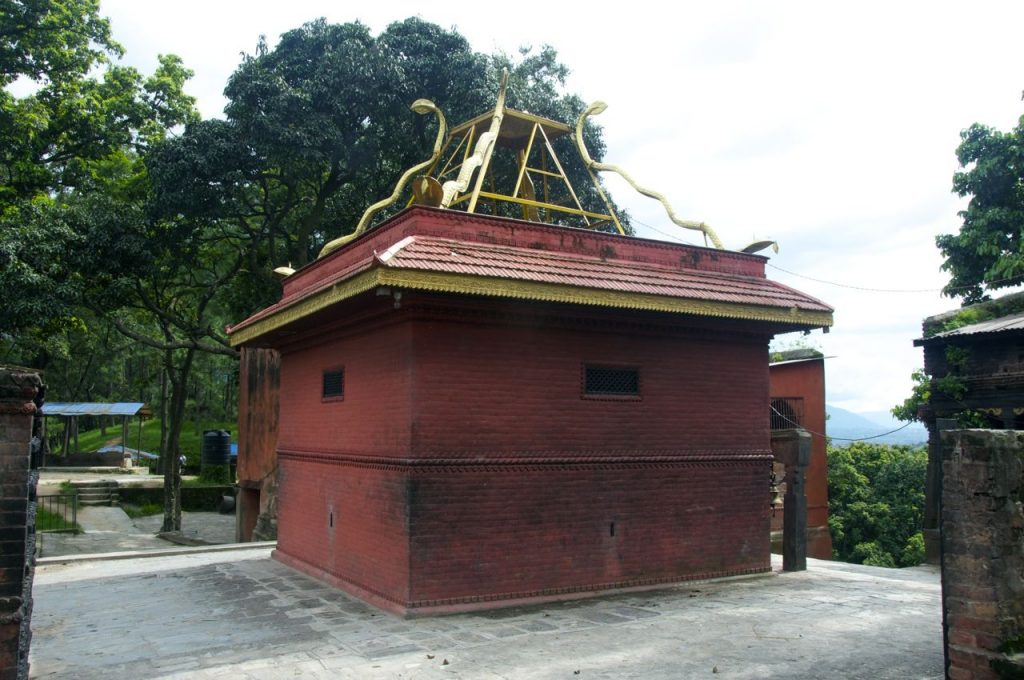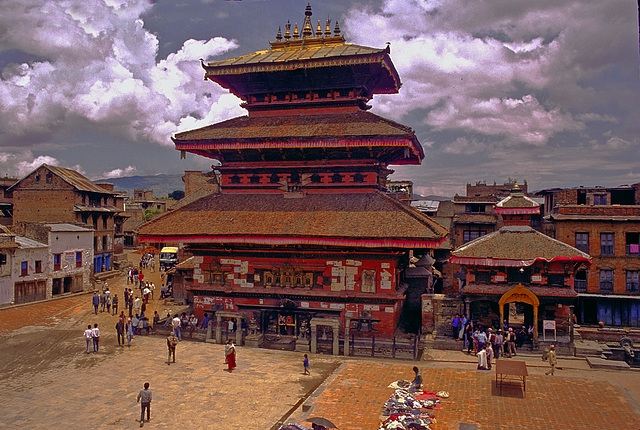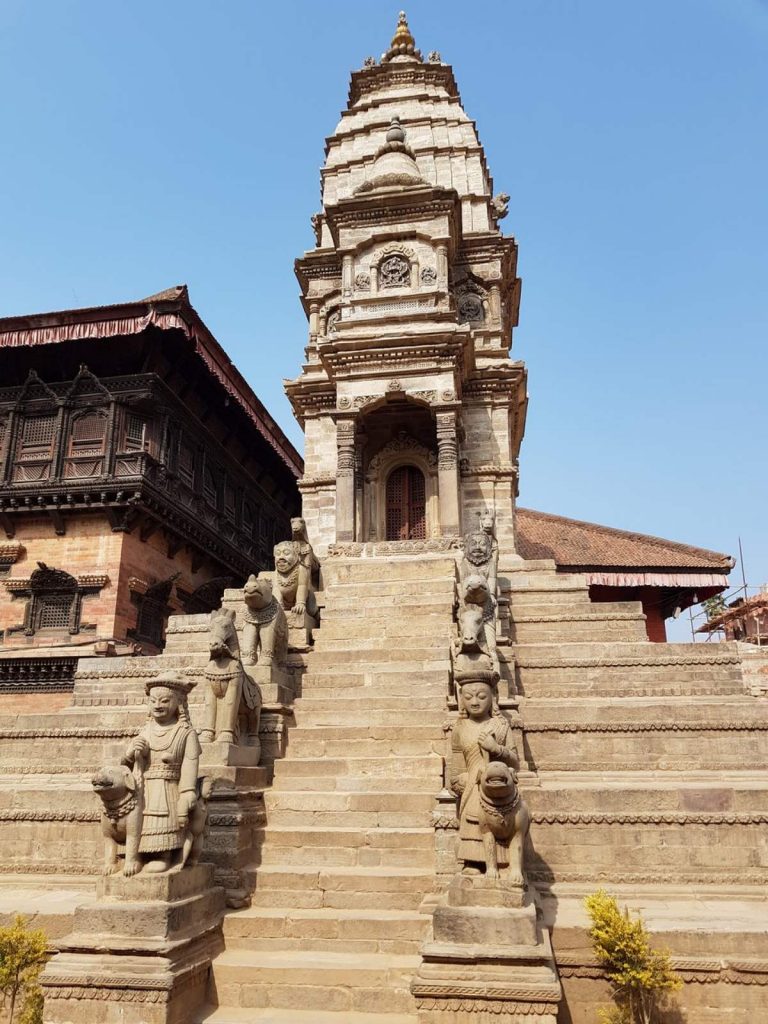Bhaktapur is one of the oldest towns of Nepal which was ruled by the Malla Kings before the unification of Nepal. This place holds the greatest historical, religious and traditional values. It is the home for the many temples, gods and goddesses. From the urban areas to the rural village area, you can experience everything in this beautiful town. The town has many world heritage sites and hill stations. It is also known as the city of devotees. It was the largest of the three Newa kingdoms of the Kathmandu valley and was the capital of Nepal during the great Malla Kingdom until the second half of the 15th century.
Bhaktapur has the best preserved palace courtyards and old city centre in Nepal and is listed as a World Heritage Site by UNESCO for its rich culture, temples and woods, metal and stone artworks. The city is also famous for a special type of yoghurt called JuJu dhau (king of the curd). It is the home of traditional art and architecture, historical monuments and craftwork, magnificent windows, pottery and weaving industries, excellent temples, beautiful ponds, rich local customs, culture, religion, festivals, musical mystic. The town is still an untouched as well as preserved ancient city.
Siddha Pokhari is an artificial rectangular pond located near the main gate of Bhaktapur Durbar Square. It is one of the old and traditional ponds in Nepal. This pond was built in the 15th century during the rule of Malla King Yakshya Malla. The pond is also called Indra Daha. The pond is surrounded by the whole wall and there are stairs above the pond. There are stalls that sell food for the fish in which the guest can buy food and feed to the fishes at the pond. It is also known by the name Ta- Pukhu.


The pond is a popular place for locals as well as tourists and they can often be seen feeding the fish with food bought from stalls nearby. A large fair takes place every year on the day of Ashwin Krishna Dwithiya. The devotees come here to dip into the holy water and worship goddess Indrayani. The entire pond is decorated with lamps during this day. There are idols of Shiva, Shakti, Baishnav and Buddha near the pond. Devotees take dip into water so that they will be blessed with health and happiness. It is mostly crowded during the public holidays. Many youngsters come to this place to take pictures and spend the quality time with their friends and families.
Neel Barahi is the famous tantric temple located in the forest of Madhyapur Thimi in Bhaktapur district. The temple is situated on a hillock in the middle of a forest in Bode. It is build in the pagoda style with the various carvings and artecrafts. The temple was constructed during the medieval era. It is constructed in a style similar to Guhyeshwori and Dakshinkali temple. However, the main shrine of the temple is quite different from the other temples and it houses a simple rock, which is the main object or idol of the temple.


The temple also contains Gavaksha covered with metal plates, which is believed to protect the main deity of the shrine. Every year, during Rishi Purnima, the residents of Bode perform the Neel Barahi dance for four days. The dance is known as the Pyakhan in the local Newari language. It consists of the 19 dancers accompanied by an orchestra of twenty seven different instruments.
Bhairav Nath temple is another historical site located inside the Bhaktapur Durbar Square. The temple is dedicated to Bhairav, the fearsome incarnation of Shiva. Despite Bhairav’s fearsome powers and his massive temple, the deity is depicted here as a disembodied head just 15 cm high. The first temple was of a modest structure built in the early 17th century but King Bhupatindra Malla added an extra storey in 1717 and a third level was added when the temple was rebuilt after the 1934 earthquake. The final version of the temple has a similar rectangular plan to the Bhimsen Temple in Patan’s Durbar Square.


A small hole in the temple’s central door is used to push offerings into the temple’s interior. The priest enters the main shrine of the temple through the small Betal Temple on the south side of the main pagoda. It is guarded by two brass lions holding the flag of Nepal. To the right of the door is an image of Bhairav painted on rattan, decorated with a gruesome garland of buffalo guts. There are enormous wheels of the chariot to the north wall of the temple used to haul the image of Bhairav around the town during the Bisket Jatra festival in mid- April.
The fifty five windows palace is one of the most beautiful architectural features of the Bhaktapur Durbar square. The palace was constructed in 1677 AD by the Malla king Bhupatindra Malla. This palace is known as the fifty five windows palace because it has fifty five carved wooden windows on its facade. This palace is built around a number of inner courtyards that are linked together. It is said that during the Malla regime, there were ninety nine courtyards originally but only nine of them are present today. It is the main attraction of the Bhaktapur as it has many arts and artecrafts crafted on its windows.


These windows are the true example of fine Malla arts and architecture. Another remarkable feature of this palace is the main entrance gate called ”The Golden Gate”. The gate was later added by King Jayasthiti Malla in the early 18th century. This gate is decorated by gold plated embossed metal works. It leads to the first courtyard of the palace. Non- Hindus may only continue on to Taleju Chowk but everyone can visit the ornate royal water tank Naga Pokhari. Today also 55 windows palace still stands as Bhaktapur’s Royal Palace on ceremonial occasions.
Vatsala Durga Temple is a temple built in the India Shikhara Style. This temple was completely destroyed by the earthquake of 2015 and the work of reconstruction and repairing is still going on. This stone temple was built by the King Jagat Prakash Malla in 1727 AD. Beside the temple is an ornate sunken hiti containing a fine stone dhara in the form of makara, topped by a crocodile and a frog.


Siddhi Laxmi Temple is the stone temple built in the 17th century which is situated on the premises of Bhaktapur Durbar Square. The temple is built in the classic Shikhara style commonly seen in Northern India. It is on the base of the levels where there stand a male and female attendants, each leading a child and a rather eager looking dog. On successive levels the stairs are flanked by horses, garland rhinos, human faced lions and camels. Behind the temple is a neglected corner of Durbar Square that contains a pair of massive, lost looking curly haired stone lions.


Bhaktapur is the major tourist attraction of the country with the many historical and legendary stories that have bound the religion, culture and tradition of this beautiful ancient town.
Shopping is my option in contrast to Red Bull. Regardless…


Hundreds of years of preservation and perseverance, nourished and timely…
Among the many 12 years festivals Nepal has, Lha Phewa…